
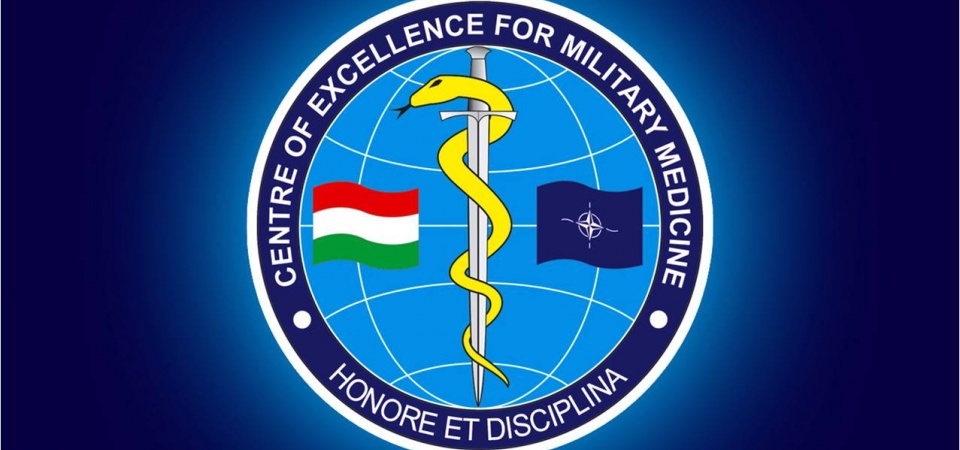
Article: K.A. FERLAND, S. KOWITZ, B. QUEYRIAUX, P. VEKSZLER, CH. WESTBROOK (COE) nn
Committed to the Health of our Forces
Valuable contribution to NATO Operations and Transformation provided by MILMED COE
In October 2009, the North Atlantic Council (NAC) accredited and activated the NATO Medical Centre of Excellence for Military Medicine (MILMED COE) in Budapest, Hungary to provide medical expertise for the improvement and transformation of the Alliance. Since that time the COE has grown from 7 initial Sponsoring Nations to 9 currently with each Sponsoring Nation providing staff members. The USA is in the process of joining and the Centre is always interested in gaining additional members. Currently the multinational staffconsists of 42 members from The Kingdom of Belgium, Czech Republic, France, Germany, Hungary, Italy, The Netherlands, Romania and The United Kingdom of Great Britain). As the Frame Work Nation, Hungary provides the bulk of support to include 62% of both the staff and budget. In line with MC 324/2, NATO MILMED COE, as an accredited NATO body, is an important contributor to the functioning of the NATO Command Structure.
The position of the Director rotates between Hungary and Germany. The first and founding director was General Dr. Istvan Kopcso, who led the NATO MILMED COE between 2009 and 2013.The current Director, Brigadier General Dr. Stefan Kowitz will hand over the Directorship of the NATO MILMED COE to the current Deputy Director, Colonel Dr. László Fazekas in July 2016.The Centre is pleased to take this opportunity to highlight selected activities and results of NATO MILMED COE’s work.
As noted in NATO doctrine “Principles and Policies of Medical Support” (MC 326-3), “the aim of military medical support on operations is to support the commander's intention through timely and effective health and medical services to the troops to achieve outcomes of medical care equating to best medical practice.” The mission of NATO MILMED COE is to develop and to implement projects to empower superior and effective medical support services across NATO, during missions abroad and in their home countries demonstrating our vision “Committed to the Health of our Forces.”
The mission of NATO MILMED COE supports the NATO Medical Vision: “NATO has Sufficient, Capable, Prepared and Interoperable Medical Forces of the appropriate quality to meet the NATO Level of Ambition and able to operate within a Comprehensive Approach”.
* Parts of the article have been used for an overview at the Three Swords Magazine at the Joint Warfare Centre [d1]
NATO MILMED COE is composed of 5 branches: Support, Training, Lessons Learned, Interoperability and Deployment Health Surveillance Capability (DHSC) Branch which is a satellite branch located in Munich, Germany with host nation support provided by Germany.The NATO MILMED COE is the only centre with a satellite branch, which is located in a country other than the Framework Nation.
MILMED COE: A Facilitator for Training
Soon after the founding of the Centre, three courses were sponsored by the COE. By 2016, NATO MILMED COE’s training offerings has grown to 10 courses supported and facilitated by the Centre with 12-14 iterations per year.
7 of these courses have NATO accreditation as “NATO SELECTED” and all courses have Continuing Medical Education Credit Points for physicians and nurses. During the last 6 years we facilitated or provided training to 1039 attendees from 47 countries representing an 87% course fill rate and since 2014 10.2% of all these students were from NATO partner nations.
The primary characteristic of our courses is the utilization of highly specialized and professionel subject matter experts which is noted in the overall student satisfaction score of 4.3 (with 5.0 being the best possible score) for all our courses.This ensure that all of the COE assiciated courses prepare students for deployment and exercises and all are defined and delivered in accordance with principles of NATO Global Programming and the NATO Systems Approach to Training (SAT). For further information on the courses, their intended audiences, and the course calendar please visit the www.coemed.org or the NATO Education and Training Online Calendar (ETOC).
The courses do not necessarily take place at the Centre, instead the main training facilities for our courses are located in Germany (Feldkirchen and Hamburg 4 courses), Marseille (one course) and Budapest (one course) with the remaining courses, supported by Mobile Training Teams, taking place at various locations based on the interest and convenience of the partner organization. However, in order to assure quality, a Course Director and administrative personnel are provided, as a minimum, to each course supported and facilitated by MILMED COE. External lecturers and/or SMEs providing support to a MILMED COE courses are chosen by the Course Directors with selection criteria including, as mentioned above, the lecturer’s scientific degree, experience, knowledge, teaching abilities and subject matter expertise in a given area.
To keep pace with the changes that occur in the medical world within the military and civilian environment, courses of the MILMED COE remain flexible and adaptable and continuously improve and develop to assure quality and relevancy. In order to accomplish this, courses are regularly assessed taking into account the external factors, changing requirements related to the developments in civilian and military medical environment, along with the health risks and threats.
The latest course development for 2016 is the direct result of the Annual Discipline Conference from last year and is a solution for an identified medical support training gap. After the approval by the Committee of the Chiefs of Military Medical Services in NATO (COMEDS), MILMED COE, together with representatives of NATO School Oberammergau, Allied Command Operations (ACO) and Allied Command Transformation (ACT) have developed a “Medical Staff Officers Introduction Course” with the first offering occurring 5-8 December 2016 in Budapest.
Medical Exercises
How to train Multinational Medical Commands and Units: Vigorous Warrior Exercise Series
The Vigorous Warrior (VW) exercise series started in Hungary 2011 with 5 nations and 100 attendees. This multinational medical NATO exercise is organized every other year, hosted by the Medical Services of different NATO Nation.The Exercise is facilitated and coordinated by MILMED COE who has collected vast experience regarding the execution of the exercise in accordance with the Bi-Strategic Directive for Collective Training and Exercise (075-003).
The most recent iteration, VW15, was part of the NATO Military Training and Exercise Program (MTEP) and the only NATO Medical Exercise scheduled during 2015. Nearly 350 military medical professionals from 14 nations joined together to participate in this training opportunity for individuals, as well as national and multinational medical units. The main focus of VW15 was biodefence in order to better prepare for the intentional release of Warfare agents or natural infectious disease outbreaks. In this exercise, the evaluation, analysis, and assessment of research processes were combined with the integration of doctrine in medical units and facilities. Different deployable mobile laboratories provided sophisticated capabilities and demonstrated the ability to provide detailed information to Military and Medical leadership. Another important aspect of the exercise was the testing of different Standardization Agreements (STANAG). One example of this was the evaluation of the procedures to quickly deploy a team of experts capable of investigating a disease outbreak, the Rapidly Deployable Outbreak Investigation Team (RDOIT), in a biological environment.
Experience from the VW series shows the importance of including realistic medical scenario as events or injects to exercises. More realistic events or injects ensure that participants gain robust experiences and are able to learn at an increased rate. During VW 15, the quality and challenge of the injects and the simulation of the continuum of care were improved by the introduction of case managers, whose task is to provide exercise “patients” with realistic response to clinical actions carried out by the medical personal.
Through the above work and the continued focused on providing strong, realistic training, we are excited to note that for VW17 which is being developed as a “walk phase” preparation for Trident Juncture (TJ) 18, which is being planned as an Article 5 scenario and will include the largest medical component for any TJ exercise to date.As for VW13 the German Medical Service has stepped up again to host VW17 and at the moment 19 Nations, including some from outside Europe, have committed personal to the exercise increasing the training audience to over 600.
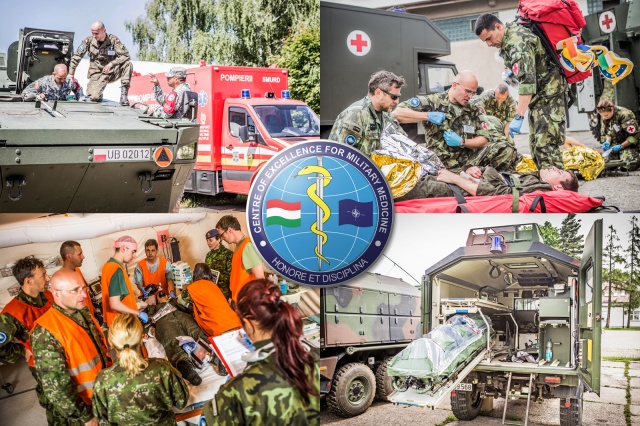 Photo: Exercise Vigorous Warrior 2015 in Hradec Kralove, Czech Republic
Photo by LT Ákos Szénási (MILMED COE)
Photo: Exercise Vigorous Warrior 2015 in Hradec Kralove, Czech Republic
Photo by LT Ákos Szénási (MILMED COE)
MILMED COE Medical Evaluation
How to know that a deploying Medical Unit and Command is capable
A basic requirement for any deploying force is the ability to complete the expected tasks.The way this is done is through an Evaluation process.The MILMED COE serves as the central hub for Medical Evaluations (MEDEVAL) in order to ensure NATO common standards are utilized in Military Medical Support to Operations. In line with MC 326-3, the conduct of Medical Evaluations supports the overarching goal of achieving best medical practice. For this task the MC 326/3 is supported by STANAG 2560, "Evaluation of NATO Medical Treatment Facilities", which was developed with significant input from MILMED COE. To improve interoperability and to support multinational solutions for medical support, MILMED COE coordinates all Medical Evaluations which are always conducted by certified medical evaluators. Currently a primary focus for Medical Evaluations is on certifying Multinational Medical Units assigned to NATO Response Forces (NRF) and Very High Readiness Joint Task Force (VJTF) and additionally, national and or multinational medical units assigned to the Operational Capabilities Concept of the Partnership programme (OCC).This focus ensures that NATO Partner Nation medical units are able to meet the same standards as NATO member nations.
During the last 2 years MILMED COE supported 8 Evaluations of medical units from different nations. Based on an official request from the Chief of Staff SHAPE, the most recent MEDEVAL was organized and conducted by MILMED COE's Training Branch for the USA 212th Combat Support Hospital (CSH) in April 2016. It was the first time that a medical facility has gone through the entire process of a NATO MEDEVAL as outlined in AMedP 1.6, the “Medical Evaluation Manual”. This NATO MEDEVAL will lead to the 212th CSH becoming the first Hospital to be certified by ACO, based on the completion of the MEDEVAL process. With the evaluation and certification, the CSH can more easily integrate the medical personnel of NATO Allies or Partner Nations.
 Photo: MEDEVAL team at USA 212th Combat Support Hospital (CSH) in April 2016
Photo by CPT Tonia Jordan (212th CSH)
Photo: MEDEVAL team at USA 212th Combat Support Hospital (CSH) in April 2016
Photo by CPT Tonia Jordan (212th CSH)
Beside the actual certification of medical units, MILMED COE executes the NATO Medical Evaluation Course, which can be organized as a Mobile Training Team course at different locations. The overall aim of the MEDEVAL Course is to provide students with the appropriate skills to be able to evaluate medical units under the auspices of their national military medical leadership. The MEDEVAL Course is accredited by NATO, as well as by the Semmelweis University in Budapest and the Hungarian National Institute for Quality and Organizational Development in Healthcare and Medicine - thus granting Continuing Medical Education (CME) credit points for physicians and nurses.
After the successful completion of the MEDEVAL Course, the students can refresh their knowledge on a regular basis using the Advanced Distributed Learning portal of NATO MILMED COE. Within this e-learning opportunity, two related courses are available: NATO Medical Treatment Facility Evaluation Preparation and NATO Medical Evaluator Refresher Course.
Lessons Learned
How do we learn from our successes - Improvement of Medical Lessons Learned Process
During the MILMED COE’s ISAF Medical Lessons Learned workshop held at the end of 2014, the Medical Lessons Learned process was noted to have critical shortfalls including a lack of input, problems with assigning topics for action and nationally stove-piped processes.
Coincidentally to this workshop, the Armed Forces Declaration produced at the Wales Summit of the NATO Heads of State directed NATO to analyse how to enhance the sharing of information on Best Practices and Lessons Learned on medical support to Armed Forces personnel.The MILMED COE produced a recommendation that was presented to COMEDS and was used as that body’s report to the Military Committee.
In the final report from COMEDS it is stated that “the Centre of Excellence for Military Medicine (MILMED COE) plays the pivotal role in catalysing, recording and disseminating the learning of lessons and sharing of best practices”. Since that time the Lessons Learned Branch of MILMED COE has been developing a comprehensive observation collection and tasking process that is based on and linked to the Lessons Learned (LL) process presented in the Bi-SC Command Directive (Bi-SCD) 080-006. In addition to the gaps noted above another driving force behind the development of this enhancement is the increasingly interconnected and interdependent relationship between military and non-military medical support.
Key integrated characteristics and improvements of the process include: enhanced responsiveness; centralization with clear delineation of the authorities; easy and intuitive access; ability to provide cross-organizational partnering; connection to National and NATO LL processes; passive and active data collection; integration with Civilian medical expertise; creation of SME networks; and the active support of all levels of NATO Medical Services and NATO Member Nations.
As a part of this program, MILMED COE developed a Medical Lessons Learned database for unclassified observations, Best Practices and Lessons Identified. All these activities are coordinated with the Joint Analysis Lessons Learned Centre (JALLC) for sharing of observations, documents and lessons with the eventual integration of the Lessons Learned Portal of NATO MILMED COE into the NATO Lessons Learned Network. As a result of all these activities and the developed process the number of observations and Lesson identified has increased. Based on these experiences, MILMED COE will develop a Medical Lessons Learned Field Manual for the medical community to improve the understanding of the enhancements and to empower the realization of functional LL process.
Knowledge Management
The importance of Sharing what we know
Since its founding 7 years ago, the MILMED COE has become a hub of military medical expertise and a focal point of knowledge for Military Medicine.COMEDS proposedthat ”the NATO Centre of Excellence for Military Medicine develops a NATO Medical Knowledge Management System in order to improve the collection and sharing of medical information and to facilitate the interactions of subject matter experts”. This designation as the hub for Military Medical Knowledge Management (KM) is also supported by the International Military Staff and the Chiefs of Staffs of the two strategic Headquarters of NATO Command Structure.
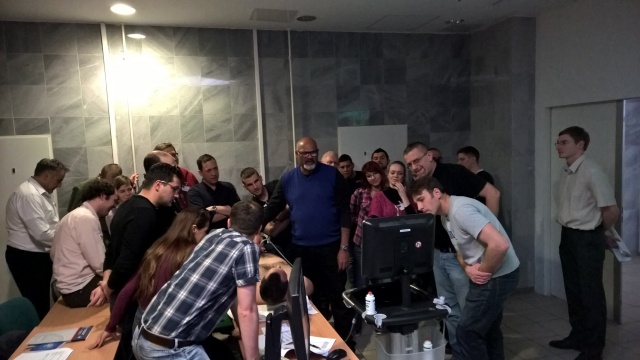 Photo: Sharing knowledge and Information - the FAST (Focused Assessment with Sonography for Trauma) exam training during a MILMED COE supported course
Photo: Sharing knowledge and Information - the FAST (Focused Assessment with Sonography for Trauma) exam training during a MILMED COE supported course
Since that time the COE has been developing a KM capability within its website. The aim of this KM capability is to capitalize on the extensive network of Subject Matter Experts (SMEs) within and associated with NATO Health Support Services and to provide an avenue for the flow of information and knowledge between key stakeholders within and outside the alliance. It is also intended to improve the collection and sharing of medical information and to facilitate the interactions of SMEs. The resources made available through this process will support the transformational goals of NATO by providing relevant data, information and knowledge on topics related to Health Support Services, especially for missions abroad within a military context and to support the work of MILMED COE.
As mentioned, Military Medicine as a discipline, is strongly connected to civilian medical developments and MILMED COE, as a knowledge centre, will remain an open institution that links military and civilian medicine together by collecting up-to-date medical knowledge and expertise from both communities and will continue to cooperate with the widest possible range of partners.
In support of the collection and sharing of Knowledge, MILMED COE executed 7 Workshops and 3 Conferences since 2104 with more than 500 attendees.These events have built up a network of SMEs and have facilitated the development of ideas and solutions for further improvement of healthcare and medical support across the militaries of the alliance. In addition, these events have fostered the strengthening and promote the active cooperation between MILMED COE and the COMEDS SME bodies (the Working Groups and Panels).
MILMED COE, together with the International Committee of Military Medicine (ICMM), the ICMM Centre of Reference for Education on International Humanitarian Law and Ethics organized a joint workshop on Military Medical Ethics in Sept 2015. The implications by ethical challenges in missions for mental health diseases was discussed and the workshop participants identified the need to develop an ethical case database as a resource for deploying leadership.
NATO MILMED COE Department Head Function
Synchronizing Medical training across the Alliance
According to Bi-SC 75-7, NATO Education and Individual Training Directive (E&ITD), trainings within NATO are supervised through NATO Global Programming as a way of ensuring that the right training is provided to the right personnel at the right time and in the right location in the most economical manner possible.In order to assist in this process, 29 disciplines, one of which is the Medical discipline, have been established across NATO.A discipline is defined as a NATO approved body of knowledge and skills that outlines an existing or evolving Education and Training requirement.Each discipline structure is managed through ACT’s Joint Force Trainer (HQ SACT JFT) and includes the assignment of a Requirements Authority (RA) and a Department Head (DH).
The MILMED COE began a pilot of the DH function for the Medical Support Discipline as a result of the 11th MILMED COE Steering Committee meeting in May 2013. COMEDS supported that decision during their 42nd Plenary and noted that MILMED COE should take over the Department Head Function. The Centre “officially” became the DH upon the signing of the Medical Support Strategic Training Plan (STP) by the Military Committee (MC) on 14 April 2015; North Atlantic Council approval occurred with their signing of the STP on 26 June 2015.Finally, the ACT appointment letter was completed in December 2015.
Bi-SC 75-2, NATO Education and Training Directive, outlines the DH responsibilities whichinclude: translating operational requirements into an education and training programme, module and/or course; applying the educational standards to which the programme, modules and courses will adhere; recommending changes to the RA; and lead/conduct the Annual Discipline Conference (ADC) on behalf of JFT, with participation from the community of interest. The Department Head Function is a multidimensional task and process which requires the involvement of the stakeholders within ACO, ACT, the International Military Staff (IMS), COMEDS Working Groups and Panels, especially the Military Medical Training Working Group, and the national representatives of training facilities. In the coming years, training and evaluation will focus on those medical assets which are designated to support the Readiness Action Plan (RAP) and are assigned to the NRF and VJTF. Therefore, MILMED COE, through the DH function, will contribute to these priorities by facilitating training and exercises that combine and include Evaluation, Lesson Learned and Improvement of Interoperability. This involves the DH function across the main pillars of the NATO MILMED COE portfolio and experiences.
NATO MILMED COE held the first ADC for Medical Support in November 2015, in Budapest, Hungary.Attendees included ACO, ACT, NATO Command and Force Structure representatives, national and multinational training facilities, and other Centres of Excellence.Major accomplishments of the conference included finding training solutions for most of the previously determined training gaps and the synchronization of medical support exercises.The identification of training solutions was achieved through recommendation of modifications to currently available course, as well as the identification of additional courses that should be developed while the exercise synchronization links Medical Support to and prepares it for inclusion into the 2018 execution of the most important NATO exercise, Trident Juncture.
Ensuring Quality - QA Accreditation
In May 2015, NATO MILMED COE applied for Institutional Accreditation through ACT’s Quality Assurance (QA) program.This process, led by the DH representative and the Quality Manager and carried out by the entire staff of the COE, resulted in an update to multiple programs and processes including the Centre’s Strategic Plan, multiple SOP’s and directives, and the development of a new QA Policy.The on-site visit of the ACT QA Team of Experts occurred in May 2016.While we are awaiting the final results of the assessment, the MILMED COE still counts the experience as a huge success due to the continuous process improvements that have and will continue to occur as a result of this evolution.
Preventive measures for the health of deployed soldiers
Maintaining the strength of the fighting force
One of the MILMED COE missions is to counter the effects of diseases through monitoring the overall health of the fighting forces by tracking the illness and symptoms that are experienced by deployed members.Since its inception, the NATO MILMED COE’s Deployment Health Surveillance (DHSC) Branch in Munich has provided a mechanism that looks across national bounds and enables NATO military leaders to obtain timely information regarding ongoing health risks.Not only does this capability improve NATO’s ability to respond to naturally occurring outbreaks, it also acts as an early warning mechanism for the use of Biological warfare agents against NATO nations and troops.
By using the system in response to the Ebola crisis of the last couple years, MILMED COE was able to monitor the health of deployed forces in Africa.The experience gained during this naturally occurring epidemic has provided invaluable experience and knowledge for preparing the response to an intentional outbreak.
In order to potentiate the knowledge and information learned during the Ebola response, the DHSC served as the hub of information and coordination for multinational, military and civilian, stakeholders.These services included providing early medical information to medical directors and military command structures and leveraging the previously developed network of public health centres across the alliance.Additionally, the DHSC branch acted as the main Point of Contact for Ebola related questions for NATO and EU Military Medical Services, publishing a weekly epidemiological Situation Update and hosting a knowledge and experience exchange site within the COE’s webpage.
At the conclusion of the Ebola crisis, MILMED COE, in partnership with the US Regional Health Command Europe (RHCE) and French Forces Epidemiology and Public Health Centre (CESPA) hosted an Ebola Crisis Lessons Learned Workshop in order to collect and share successes, as well as to document areas for improvement of the collective preparedness for the next major biological outbreak, whether natural or intentional.
Many details were collected, but the main conclusion of the workshop was that NATO must be prepared to provide a coordinated and unified response to future communicable disease threats in domestic or international theatres of operations. The dual-use approach of preparation for efficient, effective and sustainable response and readiness for the threat of natural B agents, increases the NATO Medical and CBRN capabilities for preparedness to respond to the consequences of deliberate use of Biological agents.
While the Ebola epidemic is a well-publicised disease outbreak, other infectious disease outbreaks have, and continue, to occur such as the small Q-Fever Outbreak that occurred within the KFOR mission in April 2106.This outbreak reminded NATO that the risk from biological agents, which can jeopardize the ability of NATO troops to fulfil their missions, is always present.MILMED COE supported the NATO medical Chain of Command by deploying assets to the region and by facilitating two courses: Deployment Health Surveillance (DHS) Course (training units) at CESPA in France, and the Medical Management of Infectious Diseases during Missions in cooperation with the Bernhard Nocht Institute for Tropical Medicine and the Bundeswehr Military Hospital in Hamburg thereby, providing NATO military Medical staff and leadership the knowledge and expertise needed to respond to and address natural and intentional infectious disease outbreaks.
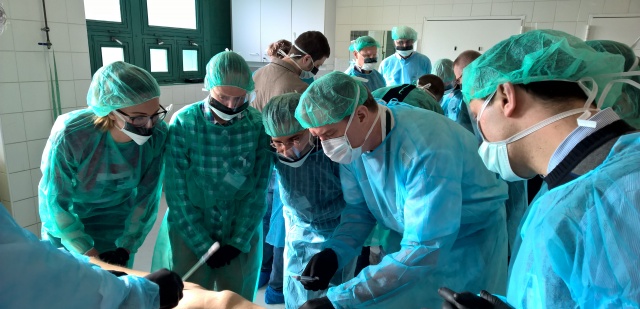 NATO Emergency Management of Battlefield Injuries (EMBI) Course in Budapest
NATO Emergency Management of Battlefield Injuries (EMBI) Course in Budapest
Mental Health Diseases
Increasing in concern across NATO
Mental health diseases of deployed soldiers have been a continuously increasing concern across NATO nations and with this in mind a workshop on Mental Health and Mild Traumatic Brain Injury, in partnership with the Europe Regional Medical Command, was held in Ramstein German in February 2015.The output from this workshop was discussed at the last COMEDS Military Mental Health Panel and will be used for possible adaptation of Doctrine and STANAGs. A very important message from the workshop is that good leadership reduces the amount of mental health disease during missions.
In order to unite the knowledge and information discovered during the workshop with improved options for the management of mental illness, MILMED COE provides the Military Psychosocial Incident Management Course which was developed in cooperation with Centre for Mental Health, Military Hospital – Queen Astrid, Belgium. The course is designed to provide the knowledge and skills for non-medical and medical leaders to effectively start up and/or to manage psychosocial care in the aftermath of a minor or major casualty incidents and to enable participants to achieve psychosocial awareness in a military multinational environment.
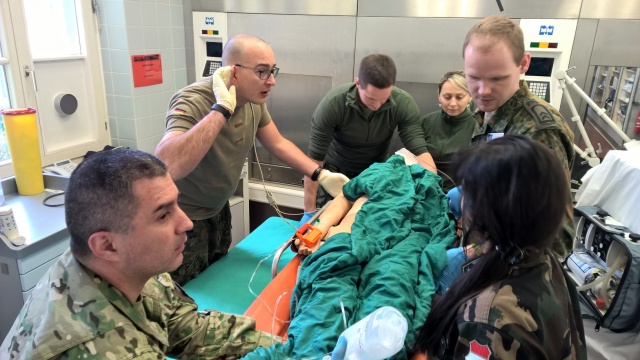 NATO Emergency Medical Multinational Team (EMMT) Training in Hamburg
NATO Emergency Medical Multinational Team (EMMT) Training in Hamburg
Future Medical Support and Prolonged Field Care
How to provide temporizing care when it is impossible to move the wounded to the next level of care
In November 2015, MILMED COE conducted a workshop with the aim to analyse the implications of Hybrid Warfare and Future Article V Missions for the Concept of NATO Medical Support. For all attendees it was clear, that the achievements of medical support in ISAF with survival rates near to 95% when reaching a medical treatment facility will be the benchmark for the future. The probable environment of the next NATO military engagement includes decreased air superiority resulting in decreased freedom of movement, reduced AIRMEDEVAC capabilities, especially Forward AIRMEDEVAC, and an increased requirement for mobility on tactical and operational levels. Taken together, the ability to transport a battle casualty from the point of injury to a Medical Facility capable of providing surgical care is expected to be significantly reduced from ISAF standards.The result is that wounded troops will require temporizing treatment within the field setting at much higher rates.
The workshop attendees noted that while getting a casualty to a surgically capable unit as fast as possible should remain the standard, “Prolonged Field Care” will be a reality. The above workshop outlined the issues and presented a list of topics for future consideration by NATO Medical Support Services.In order to address some of the issues identified at that workshop, MILMED COE and RHCE hosted a follow-on workshop on the improvement of Prehospital Care. The aim of the workshop was to collect best practices concerning Prehospital care and to begin to develop scientifically based recommendations for improvements to battle field casualty care taking into account the expectations for future conflicts.
One of the initial results of the Prehospital Workshop was the identification of two targets:1) increase the ability to perform Point-of-injury Testing to better identify the most severely injured casualties and 2) the positioning of blood products far forward of ROLE 2 MTFs. It was felt by the assembled SMEs that these two proposals are critical for optimizing survival on the battlefield. The Task Force will engage with COMEDS WGs and Panels, the NATO Science and Technology Organization and MILMED COE to analyse how to achieve the revolutionary, lifesaving changes in doctrine and planning.
As part of this program, MILMED COE together with COMEDS Military Health Care Working Group will initiate, coordinate and facilitate an overarching Task Force to synchronize the alliance - wide work that is occurring on the improvement of pre-hospital care. The reaction and the commitment of the all attendees shows, that this topic is an urgent and important issue for the future development of the medical support in missions abroad.
Important role of MILMED COE
Extensive Network and good reputation
The COE has excellent working relations with all relevant NATO bodies and working groups operating in the field of military medicine as well as many organizations outside the NATO umbrella. These achievements are reflected by the NATO and civilian university accreditation of the COE’s courses, permanent support of the Sponsoring and Partner Nations to exercise series Vigorous Warrior and the frequent request for medical evaluation of multinational medical units.
MILMED COE is linked and connected to a strong and wide network of partners and stakeholders for medial support and especially for military medicine. The results of the leading role and the work of MILMED COE have implications on the tactical, operational and strategic level for NATO and NATO Partners. MILMED COE supports and assists the current missions abroad, is in the forefront of transformation of Medical Support for the Alliance and is involved in 3 main NATO projects: NATO Defence Planning Process, Smart Defence and Connected Forces Initiative (CFI). As stated in the HQ SACT Periodic Assessment Report: „MILMED COE is a good example of “Smart Defence” in action and the cooperation that is possible”.
MILMED COE and asset for the Alliance - Furthering the transformation of NATO Medical Support Services
The greatest strength of MILMED COE is the highly experienced and dedicated staff. The few examples provided show, that NATO MILMED COE is providing high value, relevant and accessible products that enhance the delivery of Health related services across the alliance and result in improved patient outcomes and reduced commitment of resources. Based on these experiences, the importance of MILMED COE as a valuable partner and advisor in multinational military medicine has grown during the last 7 years.
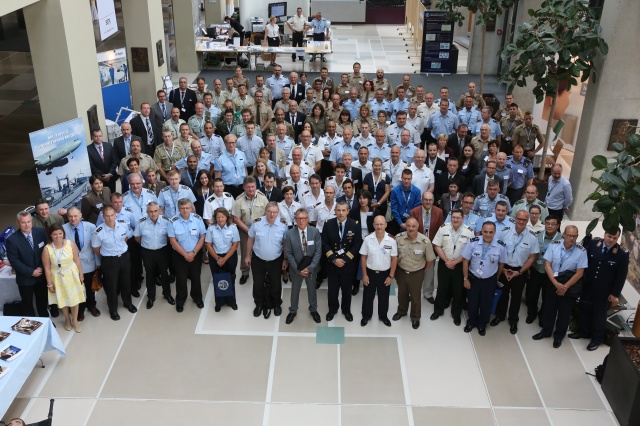 Photo: NATO Force Health Protection conference organized together with Beta Publishing in Budapest 2014
Photo by Lajos Szabó (HUN MoD)
Photo: NATO Force Health Protection conference organized together with Beta Publishing in Budapest 2014
Photo by Lajos Szabó (HUN MoD)
- www.coemed.org
- Email: info@coemed.org Phone: +36 1 883 0100 Fax: +36 1 883 0127
[d1]It should be at the end of the page in a footer or at the end of the entire article
Date: 04/14/2016
Source: MCIF 2/16










